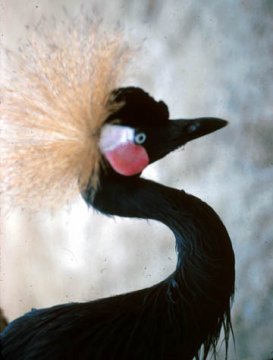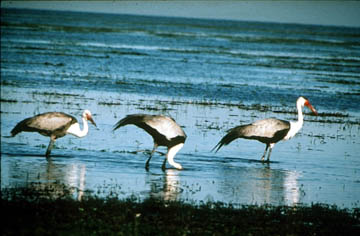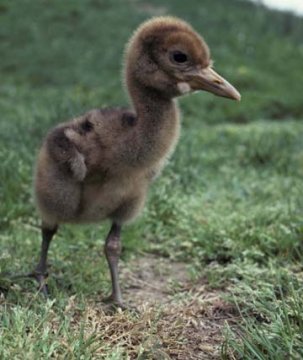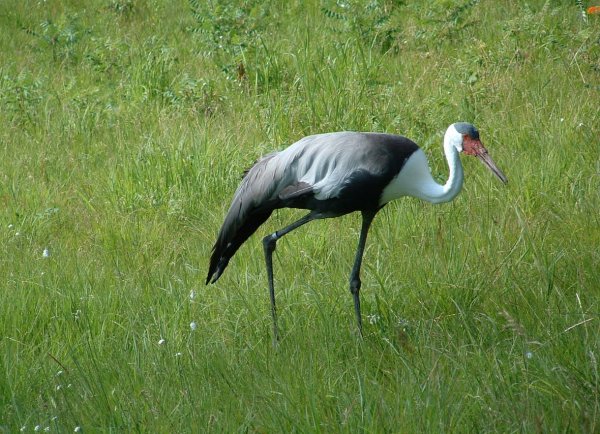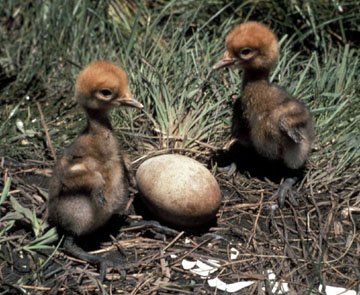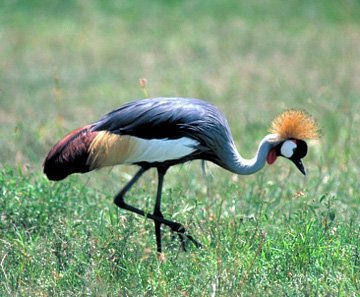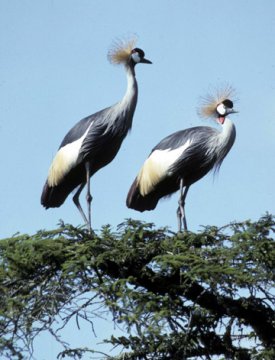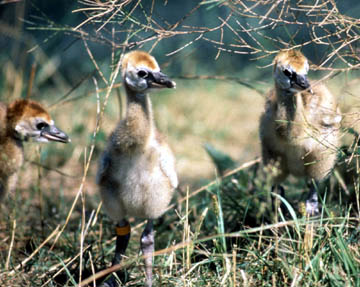Black
Crowned Crane, Balearica pavonina
The Black Crowned Crane, Balearica pavonina, is a bird in
the crane family Gruidae. It was once called also Kaffir
Crane.
It occurs in dry savannah in Africa south of the Sahara, although
in nests in somewhat wetter habitats. There are two subspecies:
Balearica pavonina pavonina in the west and the more
numerous Balearica pavonina ceciliae in east Africa.
 Black
Crowned Crane, Balearica pavonina
Black
Crowned Crane, Balearica pavonina
|
This species and the closely related Grey Crowned Crane, Balearica
regulorum, which prefers wetter habitats for foraging,
are the only cranes that can nest in trees. It is about 1
m long, has a 1.87 m wingspan and weighs about 3.6 kg.
Like all cranes, the Black Crowned Crane eats grass, insects,
reptiles, and small mammals. It is endangered, especially
in the west, by habitat loss and degradation.
Source: http://en.wikipedia.org/wiki/Black_Crowned_Crane
The body of the Black
Crowned Crane is mostly black, with distinctive white upper
and under wing coverts. The head is
topped with a crown of stiff golden feathers. Cheek patches
are red and white. The subspecies are most easily distinguished
by the differences in the coloration of their cheek patches.
In the West African subspecies, the lower half of the cheek
patch
is red; in the Sudan subspecies, the red extends into the
upper half of the cheek patch. The gular sac under the chin
is small
and dark. The gular sac is similar to a wattle, except that
it can be inflated. Legs, toes, and bill are black.
All crowned cranes have the ability to perch because their
long hind toe (hallux) allows for grasping. Males and females
are virtually indistinguishable, although males tend to be
slightly larger.
Black Crowned Cranes use both wet and dry open habitats, but
prefer freshwater marshes, wetter grasslands, and the
edges of water bodies. Black Crowned Cranes are considered
both year-round residents and local migrants, flocking
during the dry non-breeding season.
The Black Crowned Crane's circular nest platforms are built
of grasses and sedges within or along the edges of densely
vegetated wetlands. Females lay 2-5 eggs and incubation (by
both sexes) lasts 28-31 days. Both parents guard the nest.
When the female leaves the nest to forage, the male often
guards by perching on a nearby tree. The male will sound an
alarm call if a threat is perceived. Chicks fledge (first
flight) at 60-100 days.
Threats:
Illegal capture and trade for the pet industry is the
most serious threat to Black Crowned Cranes. There is
an ancient
tradition in West African countries such as Mali, to
keep domesticated Black Crowned Cranes at household
compounds . However, in the past 30 years, international
trade in the species has accelerated. Other threats
facing the
Black Crowned Crane are the loss, transformation, and
degradation of habitat. In West Africa, wetlands and
grasslands
have been devastated by natural forces (drought) and
by the intensification of human land use
(overgrazing, destruction of tree cover.)
As per 2001 their number was estimated to about 75.000. |
Wattled
Crane, Bugeranus carunculatus
The Wattled Crane, Bugeranus carunculatus is
a large bird found in Africa south of the Sahara Desert.
It is monotypical for its genus.
At a height of up to 175 centimetres, it is the largest crane
in Africa and is the second tallest species of crane, after
the
Sarus Crane. The wingspan is 230–260 centimetres, the
length is typically 120 centimetres and weight is 6.4–7.9
kilograms
in females, 7.5–9 kilograms in males. The back and wings
are ashy gray. The feathered portion of the head is dark slate
gray above the eyes and on the crown, but is otherwise white,
including the wattles, which are almost fully feathered and
hang down from under the upper throat. The breast, primaries,
secondaries, and tail coverts are black. The secondaries
are long and nearly reach the ground. The upper breast and
neck are white all the way to the face. The skin in front
of the
eye extending to the base of the beak and tip of the wattles
is red and bare of feathers and covered by small round
wart-like bumps. Wattled Cranes have long bills and black
legs and toes. Males and females are virtually indistinguishable,
although males tend to be slightly larger.
Juveniles have tawny body plumage, lack the bare skin on the
face, and have less prominent wattles.
The Wattled Crane
occurs in eleven sub-Saharan countries in Africa, including
an isolated population in the highlands of
Ethiopia. More than half of the world’s Wattled Cranes
occur in Zambia, but the single largest concentration occurs
in
the Okavango Delta of Botswana.
Source: http://en.wikipedia.org/wiki/Wattled_Crane
 Wattled
crane tending eggs at nest and incubating
Wattled
crane tending eggs at nest and incubating
Video: BBC Natural History Unit
Audio: Natural FX and The British Library Sound Archive
www.arkive.org
|
Threats
Destruction, alteration, and degradation of wetland
habitats constitute the most significant threats to
the Wattled Crane.
Hydroelectric power projects and other water development
have caused fundamental changes in the species expansive
floodplain habitats, and their most important food source
Eleocharis spp. Human and livestock disturbance, powerline
collisions, mass aerial spraying of tsetse flies, and
illegal collection of eggs, chicks and adults for food
are also significant
threats to Wattled Cranes throughout their range.
As per 2001 their number was estimated to 13.000 - 15.000.
|
Blue
Crane, Anthropoides paradiseus
The Blue Crane, Anthropoides paradiseus, also known as
the Stanley Crane and the Paradise Crane, is the national
bird of
South Africa. It is a tall, ground-dwelling bird, but
is fairly small by the standards of the crane family.
It is 100–120 cm tall
and weighs 4.0–6.2 kg. This crane is pale blue-gray
in colour with a white crown, a pink bill, and long, dark
gray wingtip
feathers which trail to the ground. Unlike most cranes,
it has a relatively large head and a proportionately thin
neck.
Blue Cranes, the national bird of South Africa, are endemic
(only found in a certain region) to southern Africa, with
more than
99% of the population occurring within South Africa. The
Blue Crane is the national bird of South Africa. A small
disjunct
breeding population of approximately 60 individuals exists
in northern Namibia, in and around Etosha Pan. [1]
Blue Cranes are birds of the dry grassy uplands. They
feed on seeds and snakes and spend little time in wetlands.
They are
altitudinal migrants, generally nesting in the lower grasslands
and moving down to lower altitudes for winter.
Many occupy agricultural areas.
Of the 15 species of crane, the Blue Crane has the most
restricted distribution of all.
 Blue
crane - overview
Blue
crane - overview
Video:
Granada Wild
Audio: The British Library Sound Archive and Natural
FX
www.arkive.org
|
|
Threats.
While it remains common in parts of its historic
range, and approx. 26,000 individuals remain, it
began a sudden population decline from around 1980
and is now classified as vulnerable.
In the last two decades, the Blue Crane has largely
disappeared from the Eastern Cape, Lesotho, and
Swaziland.
The population in the northern Free State, western
cape, Limpopo, Gauteng, Mpumalanga and North West
Province
has declined by up to 1%. The majority of the remaining
population is in eastern and southern South Africa,
with a
small and separate population in the Etosha Pan
of northern Namibia. Occasionally, isolated breeding
pairs are found
in five neighboring countries.
The primary causes of the sudden decline of the
Blue Crane are human population growth, the conversion
of grasslands
into commercial tree plantations, and poisoning:
deliberate (to protect crops) or accidental (baits
intended for other
species, and as a side-effect of crop dusting).
As per 2001 their number was estimated to 15.000
- 18.000.
|
Grey
Crowned Crane, Balearica regulorum
The
Grey Crowned Crane, Balearica regulorum, is a bird
in the crane family Gruidae. It occurs in dry savannah
in Africa
south of the Sahara, although it nests in somewhat wetter
habitats. This animal does not migrate.
There are two subspecies. The East African Balearica
regulorum
gibbericeps (Crested Crane) occurs from eastern
Democratic Republic of the Congo through Uganda, of which
it is the national bird, and Kenya to eastern South Africa.
It has a larger area of bare red facial skin above the
white patch than the smaller nominate species,
Balearica regulorum
regulorum
(South African Crowned Crane), which breeds from Angola
south to South Africa.
This species and the closely related Black Crowned Crane
are the only cranes that can roost in trees, because of
a long hind
toe that can grasp branches.
The
Grey Crowned Crane has a breeding display involving dancing,
bowing, and jumping. It has a booming call which involves
inflation of the red gular sac. It also makes a honking
sound quite different from the trumpeting of other crane
species.
The nest is a platform of grass and other plants in tall
wetland vegetation. There have been observations of nestbuilding
in trees. The Grey Crowned Crane lays a clutch of 2-5
eggs. Incubation is performed by both sexes and lasts
28–31 days.
Chicks fledge at 56–100 days.
The Grey Crowned Crane is about 1 m tall and weighs 3.5
kg. Its body plumage is mainly grey. The wings are also
predominantly white, but contain feathers with a range
of colours. The head has a crown of stiff golden feathers.
The sides of the face are white, and there is a bright
red inflatable throat pouch. The bill is relatively short
and grey,
and the legs are black. The sexes are similar, although
males tend to be slightly larger. Young birds are greyer
than adults,
with a feathered buff face.
Although the Grey Crowned Crane remains common over much
of its range, it faces threats to its habitat due to drainage,
overgrazing, and pesticide pollution. Their total number
today is going down from about 100.000 (1990) to 90.000
(2001)
Like all cranes, it feeds on insects and other invertebrates,
reptiles, small mammals, as well as grass seeds.
The
26th meeting of the Animals Committee of the Convention
on International Trade in Endangered Species of Wild
Fauna and Flora (CITES) stated on March 27th, 2012:
Scientists expressed serious concern about trade from
certain African countries in grey-crowned and blackcrowned
cranes (Balearica regulorum and Balearica pavonina),
large waterbirds that typically inhabit open land
near inland water bodies. International trade in cranes
consists principally of live, wild-taken birds, with
trade in captive-bred specimens
also reported. Between 2000 and 2010, trade in some
1,300 live birds has been recoded.
Source:
http://allafrica.com/stories/201203221101.html |
 Grey
crowned-crane - overview
Grey
crowned-crane - overview
BBC Natural History Unit, Natural FX
www.arkive.org
|
|
|
When nothing else stated, all pictures courtesy
of
International Crane Foundation, Baraboo, Wisconsin. www.savingcranes.org
|
|





